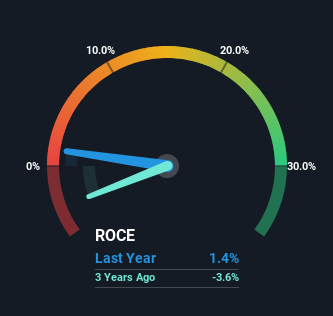- China
- /
- Communications
- /
- SHSE:603083
Returns On Capital Signal Tricky Times Ahead For CIG ShangHai (SHSE:603083)
If we want to find a potential multi-bagger, often there are underlying trends that can provide clues. Firstly, we'd want to identify a growing return on capital employed (ROCE) and then alongside that, an ever-increasing base of capital employed. Put simply, these types of businesses are compounding machines, meaning they are continually reinvesting their earnings at ever-higher rates of return. Although, when we looked at CIG ShangHai (SHSE:603083), it didn't seem to tick all of these boxes.
Return On Capital Employed (ROCE): What Is It?
For those that aren't sure what ROCE is, it measures the amount of pre-tax profits a company can generate from the capital employed in its business. To calculate this metric for CIG ShangHai, this is the formula:
Return on Capital Employed = Earnings Before Interest and Tax (EBIT) ÷ (Total Assets - Current Liabilities)
0.014 = CN¥36m ÷ (CN¥5.2b - CN¥2.6b) (Based on the trailing twelve months to March 2024).
Therefore, CIG ShangHai has an ROCE of 1.4%. In absolute terms, that's a low return and it also under-performs the Communications industry average of 3.9%.
See our latest analysis for CIG ShangHai

While the past is not representative of the future, it can be helpful to know how a company has performed historically, which is why we have this chart above. If you're interested in investigating CIG ShangHai's past further, check out this free graph covering CIG ShangHai's past earnings, revenue and cash flow.
What Does the ROCE Trend For CIG ShangHai Tell Us?
When we looked at the ROCE trend at CIG ShangHai, we didn't gain much confidence. Over the last five years, returns on capital have decreased to 1.4% from 5.2% five years ago. And considering revenue has dropped while employing more capital, we'd be cautious. If this were to continue, you might be looking at a company that is trying to reinvest for growth but is actually losing market share since sales haven't increased.
On a separate but related note, it's important to know that CIG ShangHai has a current liabilities to total assets ratio of 51%, which we'd consider pretty high. This effectively means that suppliers (or short-term creditors) are funding a large portion of the business, so just be aware that this can introduce some elements of risk. While it's not necessarily a bad thing, it can be beneficial if this ratio is lower.
The Bottom Line
From the above analysis, we find it rather worrisome that returns on capital and sales for CIG ShangHai have fallen, meanwhile the business is employing more capital than it was five years ago. Yet despite these concerning fundamentals, the stock has performed strongly with a 72% return over the last five years, so investors appear very optimistic. In any case, the current underlying trends don't bode well for long term performance so unless they reverse, we'd start looking elsewhere.
On a separate note, we've found 2 warning signs for CIG ShangHai you'll probably want to know about.
If you want to search for solid companies with great earnings, check out this free list of companies with good balance sheets and impressive returns on equity.
New: AI Stock Screener & Alerts
Our new AI Stock Screener scans the market every day to uncover opportunities.
• Dividend Powerhouses (3%+ Yield)
• Undervalued Small Caps with Insider Buying
• High growth Tech and AI Companies
Or build your own from over 50 metrics.
Have feedback on this article? Concerned about the content? Get in touch with us directly. Alternatively, email editorial-team (at) simplywallst.com.
This article by Simply Wall St is general in nature. We provide commentary based on historical data and analyst forecasts only using an unbiased methodology and our articles are not intended to be financial advice. It does not constitute a recommendation to buy or sell any stock, and does not take account of your objectives, or your financial situation. We aim to bring you long-term focused analysis driven by fundamental data. Note that our analysis may not factor in the latest price-sensitive company announcements or qualitative material. Simply Wall St has no position in any stocks mentioned.
About SHSE:603083
CIG Shanghai
Engages in the research and development, production, and sale of edge computing, industrial interconnection, and high-speed optical module products in China and internationally.
Proven track record with mediocre balance sheet.
Market Insights
Community Narratives




